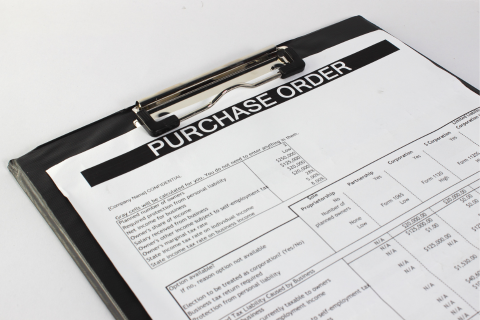In the context of food safety testing, an analysis purchase order is a document issued by a professional, sent to a laboratory or an analysis provider. This document specifies the product analysis requests and serves as a contract to facilitate the execution of quality control checks. The question raised is : What are the essential elements that must be included in this document?
Summary:
1) What is an analyis order form
2) What are the mandatory elements on your analysis purchase order ?
3) How to create your analysis purchase orders ?
4) Free Excel purchase order template to download:
What is an analysis order form ?
An order form is a commercial and contractual document that concludes an order between a professional and an analysis laboratory. It details elements necessary for effective analysis execution.
Legally, several items are required:
- The unique identification number of the company
- The mention "RCS" followed by the name of the city of the registry
- The location of the headquarters
- If applicable, a statement of being in liquidation
- For foreign commercial companies, additional details like denomination, legal form, and registration number
- If applicable, the status of tenant-manager or managing agent
Although technically a sale can be made without an order form, in the demanding context of food safety, analysis orders need to be very precise about what is to be performed by the laboratory.
Thus, a correctly filled order form not only ensures regulatory compliance but also clarifies the request, removing any ambiguity. Clear and precise analysis order forms are essential for safety, professionalism, and are part of the entire product traceability chain!
Here are the essential elements to include in your food analysis order form
What are the mandatory elements on your analysis purchase order ?
An order form always accompanies a sample sent to a laboratory for analysis. Clear and precise order forms are necessary for properly placing an analysis order, as they serve as contractual documents.
#1 - Your general informations
- Your company name and/or legal form,
- The legal structure of your business (LLC, Inc.),
- Your head office address,
- Your SIRET or SIREN number,
- The amount of your share capital for LLCs and Inc.,
- VAT number,
- Mention of the RCS (commercial and companies register) and the city where the registry is located,
- Email address for analysis reports to be sent,
- A contact person in your company for any laboratory inquiries about the analysis or sample.
#2 - The Order Number and Issue Date
A purchase order number must accompany your analysis request, regardless of its form. It should track your request and link it to the product, lot number, analyses, etc. This number must be unique and enable the traceability of your request. The date should also be included on your purchase order to facilitate tracking of events (postal delivery, sample preparer, etc.).
A unique order number and date are essential for flawless tracing of the request.
#3 - Lab informations
Your purchase order must include the address of the laboratory that will perform the analysis. It may happen that in some large laboratories, different entities are assigned to specific types of analyses, and these entities may be geographically distant (Chemistry laboratory, microbiology laboratory, contaminants laboratory, etc.). When requesting a quote from subcontracting laboratories, this information is generally clearly indicated. Include it on your purchase orders, as if the laboratory needs to resend your package to a subsidiary or another laboratory, you will inevitably lose valuable time on your deadlines!
🔬 Your purchase order should include the address of the laboratory responsible for conducting the analysis, along with a contact if available.
Here is the template of the purchase order automatically generated by CIKLab, the control analysis management software
#4 - Your customer number with the laboratory
Typically, each subcontracting laboratory assigns a number to each of its clients. It's useful to include this number on the purchase orders to streamline the ordering process and allow the laboratory to associate the corresponding quotes. It is also recommended to include the corresponding quote number for your analytical service offer.
#5 - Product identification and lot number.
The precise identification of all information related to the product under scrutiny must be presented as clearly as possible (this will appear on the laboratory test reports!).
All these elements constitute the traceability of your sample 🏷️:
- Product name
- Article code
- Lot number
- Best Before Date (BB), Expiry Date (EXP), Manufacturing Date (MFG), Shelf life, etc.
#6 - The name of the analysis.
This is the central element of the order!
It is essential to specify with precision the analyses to be performed. This section should detail the type of analyses required, such as microbiological, chemical, or contaminant analyses. Each requested analysis must be clearly identified to prevent any confusion.
- ❌ Avoid abbreviations such as ECOLI, COLI.
- ✔️ Specify Escherichia coli, or even better: Enumeration of Escherichia coli beta-glucuronidase positive.
The name of the analysis or parameter to be controlled is generally communicated on the quote from your subcontractors, often associated with a reference number (this is the laboratory's article code) which ensures clarity regarding the test to be conducted.
#7 - The method or standard used.
Each analysis must be associated with a specific method or standard; this provides value and context to the result. There are quantitative/qualitative methods, methods with high uncertainties, etc.
🔒 Conducting an analysis entails, at a minimum, a robust pair: a name & a method.
The method used will significantly influence various aspects of the analysis result:
- The expression of the result itself (in the case of Escherichia coli: enumeration or detection)
- The unit
- The sensitivity
- The LoQ (limit of quantification)
- The LoD (limit of detection)
- Uncertainty
It is preferable for the methods used to be based on recognized standards or references such as ISO, AOAC, Eur.Ph, USP etc. These methods are validated with defined levels of repeatability and reproducibility according to the matrices, ensuring agreement on the result.
#8 - The quantity of sample required for analysis.
Specify the quantity of sample required to perform the analyses. This information is essential to ensure that the laboratory has enough material to conduct the tests accurately.
⚖️ Insufficient quantity could lead to inconclusive results or the need to request additional samples.
Some analyses conducted under accreditation are only possible and valid with a certain minimum quantity of material (triplicate, retention, heterogeneity, etc.).
#9 -The negotiated deadline
Specify the deadline by which the analyses must be completed routinely. This detail is important, especially if the results are needed for urgent decisions related to product quality or safety. If the laboratory has faster turnaround times (priority) in certain cases, also indicate this as it may impact the price.
📆 A clear deadline enables effective planning of your control process and helps avoid delays.
#10 - Price
Include the unit cost of each analysis and the total cost of the analyses requested. This should cover the price of each specific analysis as well as any additional fees (sample handling, storage, disposal costs, etc.). Typically, a quote precedes the initial purchase order.
🕉️ Transparency regarding the cost prevents misunderstandings and ensures a clear and healthy business relationship between your company and the laboratory.
How to create your analysis purchase orders ?
Editing a purchase order can certainly be done in Word, Excel, or even on the subcontracting laboratories' websites. However, when you need to send multiple samples per day to different laboratories:
- You increase the risk of errors
- It's time-consuming
- It adds no extra value!
Creating an analysis purchase order is a crucial element of the quality control process. When we talk about quality control, we inevitably talk about routine, and that's not pejorative, quite the opposite! It allows us to consider the best ways to improve each step, and generating a purchase order can truly be automated.
Here's how:
- Create a list of analyses associated with methods (with prices, deadlines, quantities).
- Associate a list of laboratories that perform these analyses & methods.
- Create control plans with all the analyses to be conducted.
- With each new batch, analyses and purchase orders are automatically generated!
All of this can be automated through a quality control management software like CIKLab !
And this offers numerous advantages:
Free Excel purchase order template to download:
CIKLab offers a free Excel file to download for automating your analysis orders with subcontracting laboratories.







